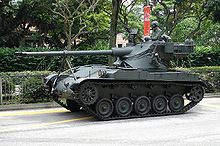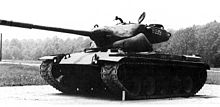
The Leclerc is a third-generation French main battle tank developed and manufactured by Nexter Systems. It was named in honour of Marshal Philippe Leclerc de Hauteclocque, a commander of the Free French Forces, who led the 2nd Armoured Division in World War II.

The AMX-13 is a French light tank produced from 1952 to 1987. It served with the French Army, as the Char 13t-75 Modèle 51, and was exported to more than 26 other nations. Named after its initial weight of 13 tonnes, and featuring a tough and reliable chassis, it was fitted with an oscillating turret built by GIAT Industries with revolver-type magazines, which were also used on the Austrian SK-105 Kürassier. Including prototypes and export versions, over a hundred variants exist, including self-propelled guns, anti-aircraft systems, APCs, and ATGM versions.

The AMX-30 is a main battle tank designed by Ateliers de construction d'Issy-les-Moulineaux and first delivered to the French Army in August 1966. The first five tanks were issued to the 501st Régiment de Chars de Combat in August of that year. The production version of the AMX-30B weighed 36 metric tons, and sacrificed protection for increased mobility. The French believed that it would have required too much armour to protect against the latest anti-tank threats, thereby reducing the tank's maneuverability. Protection, instead, was provided by the speed and the compact dimensions of the vehicle, including a height of 2.28 metres. It had a 105 mm gun, firing a then advanced high-explosive anti-tank (HEAT) warhead known as the Obus G. The Obus G used an outer shell, separated from the main charge by ball bearings, to allow the round to be spin stabilized by the gun without spinning the warhead inside which would disrupt jet formation. Mobility was provided by the 720 horsepower (540 kW) HS-110 diesel engine, although the troublesome transmission adversely affected the tank's performance.

The Panhard ERC is a French six-wheeled armoured car which is highly mobile and amphibious with an option of being NBC-proof. While various models were tested, only two versions of the ERC entered production in large numbers: the ERC-90 Lynx and the ERC-90 Sagaie. The main difference between the two versions is the type of turret and 90 mm gun fitted. Sagaie is French for assegai, a type of African spear.

The T28 Super Heavy Tank was an American super-heavy tank/assault gun designed for the United States Army during World War II. It was originally designed to break through German defenses of the Siegfried Line and was later considered as a possible participant in the planned invasion of the Japanese mainland.

A gun turret is a mounting platform from which weapons can be fired that affords protection, visibility and ability to turn and aim. A modern gun turret is generally a rotatable weapon mount that houses the crew or mechanism of a projectile-firing weapon and at the same time lets the weapon be aimed and fired in some degree of azimuth and elevation.

The Type 74 was a main battle tank (MBT) of the Japan Ground Self-Defense Force (JGSDF). It was built by Mitsubishi Heavy Industries as a supplement to the earlier Type 61. It was based on the best features of a number of contemporary designs, placing it in the same class as the US M60 Patton or German Leopard 1. Like these designs, it mounted the M68 rifled 105 mm gun. The design did not enter widespread use until 1980, by which point other Western forces had introduced more capable designs.

The AMX-10P is a French amphibious infantry fighting vehicle. It was developed from 1965 onwards to replace the AMX-VCI in the French Army. It served with the French Army from its introduction in 1973 until its retirement in 2015, when it was fully replaced by the VBCI.
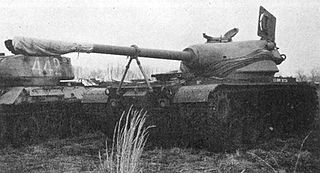
The T54 was a series of prototype American tanks of the 1950s with three different turrets, all armed with a 105 mm gun, mounted on the M48 Patton chassis. The T54 had a conventional turret with an autoloader with 3 shells, the T54E1 had an oscillating design with an autoloader, and the T54E2 had a conventional turret with a human loader.

The SK-105 Kürassier is an Austrian light tank armed with a rifled 105 mm gun in an oscillating turret. It is estimated that over 700 have been produced, with initial deliveries in 1971. It shares its CN 105-57 main gun with the French AMX-13, which was widely produced and deployed.

The Panhard EBR is an armoured car designed by Panhard for the French Army and later used across the globe, notably by the French Army during the Algerian War and by the Portuguese Army during the Portuguese Colonial War.

The AMX 50 or AMX-50 is a French heavy tank designed in the immediate post Second World War period. It was proposed as, in succession, the French medium, heavy, and main battle tank, incorporating many advanced features. It was cancelled in the late 1950s however, due to unfavourable economic and political circumstances after serious delays in development.

FV 4401 Contentious was a prototype British air-portable tank destroyer of the early 1960s. At least one prototype was constructed and tested, although no production vehicles were built or saw service.

Heavy tank project Emil, known under the cover name of Kranvagn or KRV for short, was a heavy tank developed secretly in Sweden during the early 1950s; Kranvagn, meaning mobile crane, was a cover-name. The intention was to replace the Swedish Army's disparate tank fleet with a tank that could counter the Soviet IS series heavy tanks and be upgraded continuously. The initial design, in 1950, proposed mounting a 10.5 cm autoloader in an oscillating turret. Due to its size, weight and power to weight it was considered by many to be more of a medium tank than a heavy tank.

The ELC project was a prototype light tank project launched by the French Ministry of Defense in 1955. The purpose of the ELC project was to develop a lightly armoured, heavily armed fighting vehicle capable of being airlifted for rapid deployment.
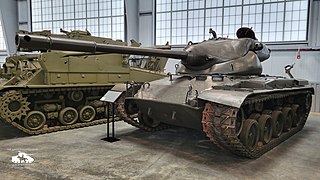
The T69 was a prototype American medium tank with an oscillating turret mounting a 90mm cannon with an eight-round drum autoloader. It held a crew of three. Developed on the basis of the T42 experimental medium tank in the mid-50s, the vehicle never entered mass production.
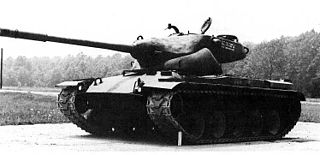
The T57 heavy tank was an experimental heavy tank developed by the American military during the Cold War era as a further development of the M103 heavy tank. Featuring heavy armor and a long range 120 mm rifled gun, the T57 was supposed to serve as a replacement to the M103 in service with American heavy tank units in Europe. Armor on the hull front was to range between 5–8 in (130–200 mm) in thickness and the turret was to be 5.98 in (152 mm) at maximum on all sides. Like the French AMX 50 project, it was to feature an oscillating turret and was also to receive a 153 mm gun. Experiments were also conducted to investigate mounting a 203 mm gun, but this was soon found to be infeasible. When multiple problems were discovered in the turret oscillation system on account of the excess weight of the heavily armored turret and the gun, the project was dropped.
The Lorraine 40t was a prototype French medium tank of the Cold War.
The Panhard AM 40 P, also known as Model 201, was a prototype French armoured car.
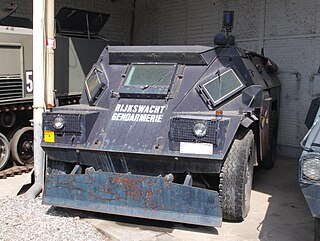
The Timoney armoured personnel carrier refers to a series of armored personnel carriers developed by Timoney Technology Limited of Ireland in the 1970s and 1980s.
